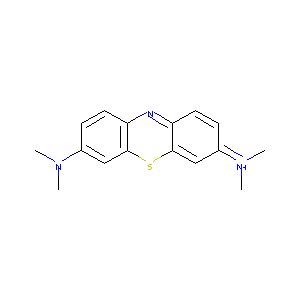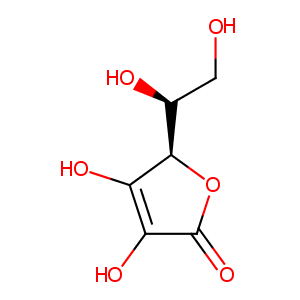| 1 |
ClinicalTrials.gov (NCT04370288) Clinical Application of Methylene Blue for Treatment of Covid-19 Patients. U.S. National Institutes of Health.
|
| 2 |
Recombinant Plasmodium falciparum glutathione reductase is inhibited by the antimalarial dye methylene blue. FEBS Lett. 1998 Feb 6;422(3):311-4.
|
| 3 |
Pathways of Gastric Carcinogenesis, Helicobacter pylori Virulence and Interactions with Antioxidant Systems, Vitamin C and Phytochemicals. Int J Mol Sci. 2020 Sep 3;21(17):6451.
|
| 4 |
Epidemiology of esophageal cancer: update in global trends, etiology and risk factors. Clin J Gastroenterol. 2020 Dec;13(6):1010-1021.
|
| 5 |
Dermatoporosis and vitamin C deficiency. J Eur Acad Dermatol Venereol. 2018 Oct;32(10):e383.
|
| 6 |
A standard database for drug repositioning. Sci Data. 2017 Mar 14;4:170029.
|
| 7 |
Integrative medicine in multiple myeloma and plasma cell disorders. Complement Ther Med. 2023 May;73:102939.
|
| 8 |
Why bortezomib cannot go with 'green'?. Cancer Biol Med. 2013 Dec;10(4):206-13.
|
| 9 |
Hydrocortisone, Vitamin C, and Thiamine for the Treatment of Severe Sepsis and Septic Shock: A Retrospective Before-After Study. Chest. 2017 Jun;151(6):1229-1238.
|
| 10 |
URL: http://www.guidetopharmacology.org Nucleic Acids Res. 2015 Oct 12. pii: gkv1037. The IUPHAR/BPS Guide to PHARMACOLOGY in 2016: towards curated quantitative interactions between 1300 protein targets and 6000 ligands. (Ligand id: 4781).
|
| 11 |
Appropriate and inappropriate vitamin supplementation in children. J Nutr Sci. 2020 Jun 5;9:e20.
|
| 12 |
Photoluminescence of CdTe nanocrystals modulated by methylene blue and DNA. A label-free luminescent signaling nanohybrid platform. Phys Chem Chem Phys. 2009 Jul 7;11(25):5062-9.
|
| 13 |
Curcumin ameliorates high glucose-induced acute vascular endothelial dysfunction in rat thoracic aorta. Clin Exp Pharmacol Physiol. 2009 Dec;36(12):1177-82.
|
| 14 |
Inhibition of the bioactivation of the neurotoxin MPTP by antioxidants, redox agents and monoamine oxidase inhibitors. Food Chem Toxicol. 2011 Aug;49(8):1773-81.
|
| 15 |
Identification of environmental chemicals that activate p53 signaling after in vitro metabolic activation. Arch Toxicol. 2022 Jul;96(7):1975-1987. doi: 10.1007/s00204-022-03291-5. Epub 2022 Apr 18.
|
| 16 |
Pharmacologic reductions of total tau levels; implications for the role of microtubule dynamics in regulating tau expression. Mol Neurodegener. 2006 Jul 26;1:6. doi: 10.1186/1750-1326-1-6.
|
| 17 |
Defenses against oxidation in human erythrocytes: role of glutathione reductase in the activation of glucose decarboxylation by hemolytic drugs. J Lab Clin Med. 1991 Apr;117(4):325-31.
|
| 18 |
Profiling the Tox21 Chemical Collection for Acetylcholinesterase Inhibition. Environ Health Perspect. 2021 Apr;129(4):47008. doi: 10.1289/EHP6993. Epub 2021 Apr 12.
|
| 19 |
ADReCS-Target: target profiles for aiding drug safety research and application. Nucleic Acids Res. 2018 Jan 4;46(D1):D911-D917. doi: 10.1093/nar/gkx899.
|
| 20 |
Antiproliferative effect of ascorbic acid is associated with the inhibition of genes necessary to cell cycle progression. PLoS One. 2009;4(2):e4409.
|
| 21 |
Synergistic effects of arsenic trioxide combined with ascorbic acid in human osteosarcoma MG-63 cells: a systems biology analysis. Eur Rev Med Pharmacol Sci. 2014;18(24):3877-88.
|
| 22 |
Improved Preventive Effects of Combined Bioactive Compounds Present in Different Blueberry Varieties as Compared to Single Phytochemicals. Nutrients. 2018 Dec 29;11(1):61. doi: 10.3390/nu11010061.
|
| 23 |
Biochemical mechanism of caffeic acid phenylethyl ester (CAPE) selective toxicity towards melanoma cell lines. Chem Biol Interact. 2010 Oct 6;188(1):1-14. doi: 10.1016/j.cbi.2010.05.018. Epub 2010 Jun 4.
|
| 24 |
URL: http://www.guidetopharmacology.org Nucleic Acids Res. 2015 Oct 12. pii: gkv1037. The IUPHAR/BPS Guide to PHARMACOLOGY in 2016: towards curated quantitative interactions between 1300 protein targets and 6000 ligands. (Target id: 1042).
|
| 25 |
Decreased expression of the vitamin C transporter SVCT1 by ascorbic acid in a human intestinal epithelial cell line. Br J Nutr. 2002 Feb;87(2):97-100.
|
| 26 |
Effects of vitamin C on dark circles of the lower eyelids: quantitative evaluation using image analysis and echogram. Skin Res Technol. 2009 May;15(2):214-7.
|
| 27 |
A family of mammalian Na+-dependent L-ascorbic acid transporters. Nature. 1999 May 6;399(6731):70-5.
|
| 28 |
Molecular characterization and transcriptional regulation of the sodium-dependent vitamin C transporter genes (slc23a1 and slc23a2) in a teleost fish, the Senegalese sole (Solea senegalensis). Comp Biochem Physiol B Biochem Mol Biol. 2012 Mar;161(3):208-18.
|
| 29 |
Ascorbic acid inhibits spinal meningeal catechol-o-methyl transferase in vitro, markedly increasing epinephrine bioavailability. Anesthesiology. 1997 Feb;86(2):405-9.
|
| 30 |
Prolyl 4-hydroxylases, the key enzymes of collagen biosynthesis. Matrix Biol. 2003 Mar;22(1):15-24.
|
| 31 |
Characterization of the human prolyl 4-hydroxylases that modify the hypoxia-inducible factor. J Biol Chem. 2003 Aug 15;278(33):30772-80.
|
| 32 |
Identification and characterization of a third human, rat, and mouse collagen prolyl 4-hydroxylase isoenzyme. J Biol Chem. 2003 Nov 28;278(48):47685-93.
|
| 33 |
Promoter analysis of the human ascorbic acid transporters SVCT1 and 2: mechanisms of adaptive regulation in liver epithelial cells. J Nutr Biochem. 2011 Apr;22(4):344-50. doi: 10.1016/j.jnutbio.2010.03.001. Epub 2010 May 14.
|
| 34 |
Effect of vitamin C on the availability of tetrahydrobiopterin in human endothelial cells. J Cardiovasc Pharmacol. 2001 Mar;37(3):333-8.
|
| 35 |
Copper ions and hypochlorite are mainly responsible for oxidative inactivation of paraoxon-hydrolyzing activity in human high density lipoprotein. Toxicol Lett. 2004 Mar 7;147(3):201-8.
|
| 36 |
Protective effect of vitamin C towards N-nitrosamine-induced DNA damage in the single-cell gel electrophoresis (SCGE)/HepG2 assay. Toxicol In Vitro. 2007 Oct;21(7):1311-7.
|
| 37 |
Ascorbic acid transported by sodium-dependent vitamin C transporter 2 stimulates steroidogenesis in human choriocarcinoma cells. Endocrinology. 2008 Jan;149(1):73-83.
|
| 38 |
Nitric oxide causes anoikis through attenuation of E-cadherin and activation of caspase-3 in human gastric carcinoma AZ-521 cells infected with Mycoplasma hyorhinis. J Vet Med Sci. 2010 Jul;72(7):869-74.
|
| 39 |
Megadose vitamin C suppresses sulfoconjugation in human colon carcinoma cell line Caco-2. Toxicol In Vitro. 2011 Mar;25(2):500-4.
|
| 40 |
Natural antioxidants exhibit chemopreventive characteristics through the regulation of CNC b-Zip transcription factors in estrogen-induced breast carcinogenesis. J Biochem Mol Toxicol. 2014 Dec;28(12):529-38.
|
| 41 |
Oxidative stress mechanisms do not discriminate between genotoxic and nongenotoxic liver carcinogens. Chem Res Toxicol. 2015 Aug 17;28(8):1636-46.
|
| 42 |
Potential osteoinductive effects of calcitriol on the m-RNA of mesenchymal stem cells derived from human alveolar periosteum. Biomed Res Int. 2016;2016:3529561.
|
| 43 |
Induction of alkaline phosphatase activity by L-ascorbic acid in human osteoblastic cells: a potential role for CK2 and Ikaros. Nutrition. 2007 Oct;23(10):745-53. doi: 10.1016/j.nut.2007.06.013. Epub 2007 Jul 30.
|
| 44 |
Pharmacologic doses of ascorbic acid repress specificity protein (Sp) transcription factors and Sp-regulated genes in colon cancer cells. Nutr Cancer. 2011;63(7):1133-42. doi: 10.1080/01635581.2011.605984. Epub 2011 Sep 15.
|
| 45 |
Ascorbic acid inhibits PMP22 expression by reducing cAMP levels. Neuromuscul Disord. 2007 Mar;17(3):248-53. doi: 10.1016/j.nmd.2006.12.008. Epub 2007 Feb 15.
|
| 46 |
Ascorbic acid enhances low-density lipoprotein receptor expression by suppressing proprotein convertase subtilisin/kexin 9 expression. J Biol Chem. 2020 Nov 20;295(47):15870-15882. doi: 10.1074/jbc.RA120.015623. Epub 2020 Sep 10.
|
| 47 |
Galbanic acid: Induced antiproliferation in estrogen receptor-negative breast cancer cells and enhanced cellular redox state in the human dermal fibroblasts. J Biochem Mol Toxicol. 2019 Nov;33(11):e22402. doi: 10.1002/jbt.22402. Epub 2019 Oct 1.
|
| 48 |
Ascorbic acid induces collagenase-1 in human periodontal ligament cells but not in MC3T3-E1 osteoblast-like cells: potential association between collagenase expression and changes in alkaline phosphatase phenotype. J Bone Miner Res. 2003 Jan;18(1):67-77. doi: 10.1359/jbmr.2003.18.1.67.
|
| 49 |
Ascorbic acid and alpha-tocopherol down-regulate apolipoprotein A-I gene expression in HepG2 and Caco-2 cell lines. Metabolism. 2006 Feb;55(2):159-67. doi: 10.1016/j.metabol.2005.08.008.
|
| 50 |
Pharmacologic concentrations of ascorbic acid cause diverse influence on differential expressions of angiogenic chemokine genes in different hepatocellular carcinoma cell lines. Biomed Pharmacother. 2010 May;64(5):348-51. doi: 10.1016/j.biopha.2009.06.005. Epub 2009 Oct 22.
|
| 51 |
Dental resin monomers induce early and potent oxidative damage on human odontoblast-like cells. Chem Biol Interact. 2021 Jan 5;333:109336. doi: 10.1016/j.cbi.2020.109336. Epub 2020 Nov 25.
|
| 52 |
Comparison of protective effect of ascorbic acid on redox and endocannabinoid systems interactions in in vitro cultured human skin fibroblasts exposed to UV radiation and hydrogen peroxide. Arch Dermatol Res. 2017 May;309(4):285-303. doi: 10.1007/s00403-017-1729-0. Epub 2017 Mar 11.
|
| 53 |
Vitamin C controls the cystic fibrosis transmembrane conductance regulator chloride channel. Proc Natl Acad Sci U S A. 2004 Mar 9;101(10):3691-6. doi: 10.1073/pnas.0308393100. Epub 2004 Mar 1.
|
| 54 |
Posttranslational glutathiolation of aldose reductase (AKR1B1): a possible mechanism of protein recovery from S-nitrosylation. Chem Biol Interact. 2009 Mar 16;178(1-3):250-8. doi: 10.1016/j.cbi.2008.11.007. Epub 2008 Nov 18.
|
| 55 |
Ascorbic acid induces in vitro proliferation of human subcutaneous adipose tissue derived mesenchymal stem cells with upregulation of embryonic stem cell pluripotency markers Oct4 and SOX 2. Hum Cell. 2010 Nov;23(4):152-5. doi: 10.1111/j.1749-0774.2010.00095.x.
|
| 56 |
Ascorbic acid uptake affects ferritin, Dcytb and Nramp2 expression in Caco-2 cells. Eur J Nutr. 2008 Oct;47(7):401-8. doi: 10.1007/s00394-008-0741-8. Epub 2008 Sep 24.
|
| 57 |
Quercetin-3-O-(2"-galloyl)--l-rhamnopyranoside prevents TRAIL-induced apoptosis in human keratinocytes by suppressing the caspase-8- and Bid-pathways and the mitochondrial pathway. Chem Biol Interact. 2013 Aug 25;204(3):144-52. doi: 10.1016/j.cbi.2013.05.009. Epub 2013 May 24.
|
| 58 |
Resveratrol compounds inhibit human holocarboxylase synthetase and cause a lean phenotype in Drosophila melanogaster. J Nutr Biochem. 2015 Nov;26(11):1379-84. doi: 10.1016/j.jnutbio.2015.07.004. Epub 2015 Jul 26.
|
| 59 |
Identification of lead-produced lipid hydroperoxides in human HepG2 cells and protection using rosmarinic and ascorbic acids with a reference to their regulatory roles on Nrf2-Keap1 antioxidant pathway. Chem Biol Interact. 2019 Dec 1;314:108847. doi: 10.1016/j.cbi.2019.108847. Epub 2019 Oct 11.
|
| 60 |
Ascorbic acid treatment corrects the phenotype of a mouse model of Charcot-Marie-Tooth disease. Nat Med. 2004 Apr;10(4):396-401. doi: 10.1038/nm1023. Epub 2004 Mar 21.
|
| 61 |
Effects of transforming growth factor-beta 1 and ascorbic acid on differentiation of human bone-marrow-derived mesenchymal stem cells into smooth muscle cell lineage. Cell Tissue Res. 2008 Sep;333(3):449-59. doi: 10.1007/s00441-008-0654-0. Epub 2008 Jul 8.
|
| 62 |
Metal ions-stimulated iron oxidation in hydroxylases facilitates stabilization of HIF-1 alpha protein. Toxicol Sci. 2009 Feb;107(2):394-403. doi: 10.1093/toxsci/kfn251. Epub 2008 Dec 13.
|
| 63 |
A cardiac-specific robotized cellular assay identified families of human ligands as inducers of PGC-1 expression and mitochondrial biogenesis. PLoS One. 2012;7(10):e46753. doi: 10.1371/journal.pone.0046753. Epub 2012 Oct 3.
|
| 64 |
Haptoglobin genotype modifies the association between dietary vitamin C and serum ascorbic acid deficiency. Am J Clin Nutr. 2010 Dec;92(6):1494-500. doi: 10.3945/ajcn.2010.29306. Epub 2010 Oct 6.
|
| 65 |
Lipid peroxidation and 4-hydroxy-2-nonenal formation by copper ion bound to amyloid-beta peptide. Free Radic Biol Med. 2007 Dec 1;43(11):1552-9. doi: 10.1016/j.freeradbiomed.2007.08.013. Epub 2007 Aug 29.
|
| 66 |
Transport mechanism and substrate specificity of human organic anion transporter 2 (hOat2 [SLC22A7]). J Pharm Pharmacol. 2005 May;57(5):573-8.
|
| 67 |
Functional genetic variants of glutathione S-transferase protect against serum ascorbic acid deficiency. Am J Clin Nutr. 2009 Nov;90(5):1411-7. doi: 10.3945/ajcn.2009.28327. Epub 2009 Aug 26.
|
|
|
|
|
|
|


